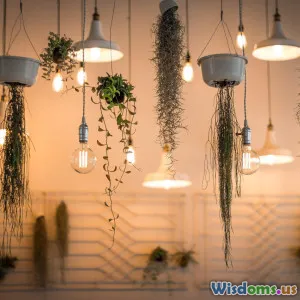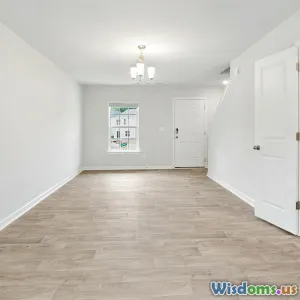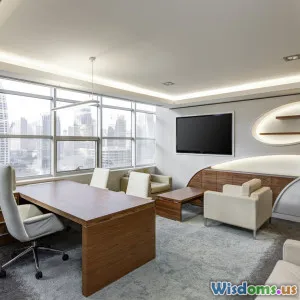
Capturing Natural Light Versus Artificial Light In Interiors
8 min read Explore how to effectively harness and balance natural and artificial light in interiors for enhanced aesthetic, mood, and functionality. (0 Reviews)
Capturing Natural Light Versus Artificial Light In Interiors
Lighting is the invisible art that shapes how we perceive and experience interior spaces. Whether opening up a cozy reading nook or illuminating an expansive living room, the source and quality of light dramatically influence our connection to environments.
In a heated debate between natural and artificial lighting within interiors, how can designers and homeowners leverage each to elevate spaces aesthetically, functionally, and psychologically? This detailed inquiry dives beneath surface preferences of sunlight and bulbs to explore technical qualities, design strategies, and experiential nuances.
Introduction: Lighting’s Irreplaceable Role in Interiors
Lighting goes far beyond mere visibility. It sculpts spatial depth, highlights textures and colors, alters mood, affects productivity, and even impacts health. Yet, capturing high-quality illumination inside buildings is a complex challenge shaped by climate, architecture, purpose, and technology.
Historically, humans relied solely on natural light sources—sunlight streaming through windows, often celebrated as a symbol of warmth and vitality. The advent of artificial lighting revolutionized interior design possibilities but introduced trade-offs involving energy use and light quality.
As awareness grows around environmental sustainability and wellbeing, the conversation intensifies over which lighting approach is most desirable or suitable for particular scenarios.
The Power and Nuance of Natural Light
Unique Qualities of Natural Light
Natural light is dynamic—changing in intensity, angle, and color temperature throughout the day and seasons. This variability infuses interiors with rhythms aligned to circadian biology, promoting alertness in morning and calm during evening.
The sun’s full spectrum light contains ultraviolet and infrared components imperceptible to our eyes but beneficial for Vitamin D synthesis and emotional upliftment.
For example, Scandinavian architecture capitalizes on maximizing scarce daylight with expansive windows and skylights, resulting in spaces feeling vibrant despite limited sunlight hours.
Psychological Benefits
Scientific studies link increased exposure to natural daylight with improved mood, reduced depression, heightened cognitive performance, and faster healing in healthcare environments.
Natural light’s ability to ‘animate’ surfaces, producing complex shadows and highlights, counters the flatness sometimes associated with artificial lighting.
Design Considerations for Maximizing Natural Light
- Orientation & Window Placement: South-facing exposures in northern hemispheres capture the most sunlight; north-facing windows render softer, cooler light good for studios.
- Glazing Types: Using low-emissivity glass or diffused glazing balances daylight admission with thermal control.
- Interior Surfaces: Light-colored walls and reflective finishes amplify natural illumination.
- Control Measures: Incorporating blinds, shutters, or smart glass allows modulation to prevent glare and overheating.
Limitations of Natural Light
Despite its allure, natural light’s availability depends heavily on geographic location, weather variability, urban density, and architectural constraints.
In densely built cities, street orientation and neighboring buildings can restrict daylight penetration. Additionally, managing solar heat gain in summer while protecting against cold winter exposure complicates design.
The Role and Advantages of Artificial Light
Types and Technologies
Artificial lighting has evolved from rudimentary firelight to high-efficiency LEDs capable of mimicking natural light’s qualities.
Common types include:
- Incandescent: Warm but inefficient, largely phased out.
- Fluorescent: Efficient yet often criticized for color rendering.
- LED (Light Emitting Diode): Highly efficient, low heat output, customizable color temperatures.
Specialty options like full-spectrum bulbs attempt to simulate daylight.
Benefits of Artificial Lighting
- Control and Consistency: Provides steady illumination regardless of external conditions.
- Flexibility: Enables layered lighting schemes (ambient, task, accent) tailored to activities and moods.
- Energy Efficiency: Modern LEDs drastically reduce electricity used compared to traditional bulbs.
Psychological and Practical Aspects
Artificial light aids night-time functioning, ensures safety, and can be tuned to support circadian rhythms through dynamic color temperature changes simulating dawn and dusk.
A well-designed artificial lighting plan considers glare reduction, uniformity, and color rendering index (CRI) to enhance interior comfort and aesthetics.
Limitations of Artificial Lighting
Poor artificial lighting can feel harsh, flat, or unnatural and may contribute to eyestrain or discomfort.
Moreover, overreliance on artificial illumination can increase energy costs and environmental footprint if not carefully managed.
Harmonizing Natural and Artificial Light
True expertise lies in integrating both light sources to complement each other.
Layered Lighting Approach
Daylight can serve as the foundation, with artificial light filling gaps and accentuating key areas.
For instance, an open-plan office might depend on generous skylights paired with adjustable desk lamps and overhead LEDs to maintain optimal light throughout the day and evening.
Smart Lighting Controls
Technologies such as daylight sensors and programmable lighting systems adapt artificial lighting levels dynamically, minimizing energy waste and enhancing user comfort.
Case Studies
- Apple’s Headquarters, Cupertino: Use of vast windows combined with intelligent LED systems creates uniformly bright, pleasant workspaces.
- Fallingwater House, Pennsylvania: Frank Lloyd Wright leveraged overhangs and water reflections to carefully modulate sunlight, while relying on subtle artificial light at night.
Practical Tips for Homeowners and Designers
- Prioritize window placement early in the design phase.
- Choose glazing with energy performance in mind.
- Think in layers: combine ambient, task, and accent lighting.
- Invest in dimmable and tunable white LED fixtures.
- Use smart controls for seamless transitions between daylight and artificial light.
- Be mindful of glare—utilize shading and diffusers.
Conclusion: Lighting as an Experiential Journey
The dialogue between natural and artificial lighting is not an either/or but a spectrum of possibilities enhanced by thoughtful design and technology.
Harnessing the unique virtues of natural sunlight while compensating with versatile artificial lighting solutions allows interiors to transcend mere function to become inspiring, nurturing environments.
In embracing both sources, we honor time-honored connections to the natural world alongside modern innovations—crafting spaces as dynamic and vibrant as life itself.
Rate the Post
User Reviews
Other posts in Interior Design
Popular Posts


















